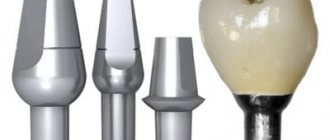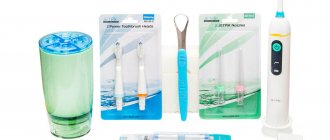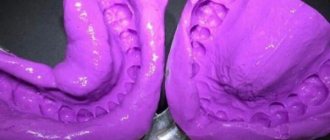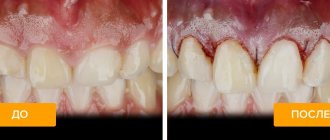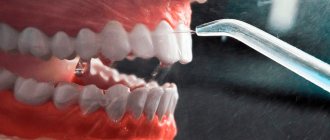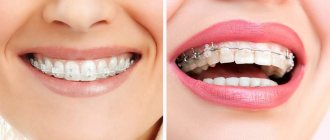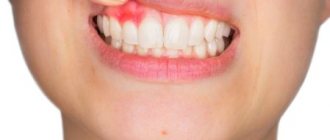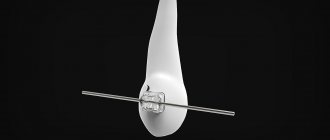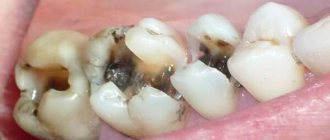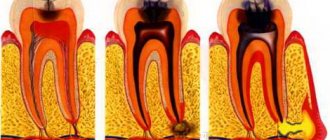From this article you will learn:
- what are abutments in dentistry,
- their options are standard and individual,
- what type of abutment is better to choose.
An abutment is a structure that is installed in a dental implant and is necessary to fix a crown or prosthesis on it. The lower part of the abutment is built into a special space inside the implant, while the upper part is an analogue of the stump of a tooth ground for a crown. Thus, abutments are a kind of “adapter” between implants and crowns (prostheses), necessary for fixing the latter to the implants.
There are a large number of abutment options in dentistry (varying in price by 3-5 times), and you should not underestimate their importance. Despite the fact that this is just some kind of “adapter”, not only the aesthetics of the entire structure, but also its service life will depend on the type and quality of the abutment. Abutments for implants can be made of titanium, zirconium dioxide (ceramics), or a hybrid version - of zirconium dioxide on a titanium base. There is also an economical option for abutments made of cobalt-chromium alloy (CHS).
Abutment options in dentistry –
Abutments can also be standard or customized. Standard abutments are ready-made “abutments out of the box”, which each manufacturer produces in several standard sizes. Their main disadvantage is the shape of their neck (transgingival part of the abutment), which will not correspond to the topography of the gums around the implant. Although this is very important, because... The gum will be directly adjacent to the neck of the abutment. Just small deviations from the ideal diameter or from the required angle of inclination of the upper part of the abutment can immediately lead to unsatisfactory esthetics.
If the diameter of a standard abutment is slightly smaller, it will not support the gum tissue well (which may require surgical reconstruction of the gum around the implant in the future). Or the abutment, on the contrary, can put pressure on the gum, and this often leads to peri-implantitis, i.e. to inflammation of the gums and destruction of the bone around the implant. At a minimum, this will mean a reduction in its service life, but sometimes it can result in rejection of the dental implant. Therefore, ideally, the abutment should only be individual - made of titanium or zirconium dioxide.
Abutment design and purpose
The word “abutment” translated from English means “support”. Previously, this concept was used to refer to the patient's natural tooth supporting the artificial crown of a bridge. But with the advent of implantation, they began to give it a different meaning, namely, support for a prosthesis.
An abutment in implantation today is a special superstructure, an intermediate or connecting link between the dental implant, which is located in the jawbone, and the top of the tooth - the crown. It is a periosteal element on which a structure is fixed that replaces the crown of a lost tooth. A single prosthesis, a bridge or a removable system can be attached to it. In essence, the product is an adapter. You can see what the abutment looks like in the photo below.
The term “suprastructure” is usually used to refer to all elements of the implantation system that allow prosthetics to be performed on implants - plugs, screws, fasteners and abutments themselves.
It is important not to confuse it with another superstructure - the gum former. This is a temporary element that is used only in classical two-stage implantation and is needed to form a beautiful gum contour around the titanium root and heal the soft tissues. It is installed for several weeks, and then changed to the required type of support element. And it can also be abutments (but temporary), but if the role of the shaper is played by a lightweight (also temporary) dental crown, which is attached to the implant immediately after its implantation.
DENTAL PROSTHESIS WITH 4 OSSTEM IMPLANTS FOR 1 JAW - RUB 130,000.
Implantation even with bone tissue atrophy. Work guarantee! Save RUR 20,000.
on promotion >> Free consultation with an implantologist +7 (495) 215-52-31 or write to us
Dental implantation in Kurkino
We offer affordable prices and carry out promotions for dental implantation with a Guarantee.
For patients who need to correct multiple defects in conditions of complete or partial edentia, our clinic has a special offer for dental implantation in Kurkino .
The final cost of installing dental implants in Moscow depends not only on the number of units, but also on the selected dental system, as well as the need for additional operations to build bone tissue.
Implantologist, dental surgeon Ph.D. Dimitrovich Denis Alexandrovich
orthopedic dentist Lyabov Roman Anatolievich
DENTAL IMPLANTATION CLINIC "APEX-D"
You can sign up for a free joint consultation to draw up a treatment plan from the administrator by phone:
+7
Sign up for a consultation
Classification of models - advantages and disadvantages of each type
In modern dentistry, high-quality solutions are created thanks to innovative technologies. Each implant manufacturer has product lines that include not only implants, but also superstructures, instruments, and biomaterials. Support elements can differ in size (diameter, length and height), angle of inclination, type of platform (narrow, standard and wide), shape, material and even installation method. Below we will consider in detail the different types of abutments.
Very often, doctors offer to install an abutment, which is produced by another company (for example, Korean), and is conditionally suitable for all implants. This option should be abandoned. The implant and superstructure that are installed on the patient must be original and come from the same manufacturer. Otherwise, they may not have perfect contact with each other - the gaps may be microscopic and completely invisible to the naked eye. But even this will be enough for the development of complications, up to complete rejection of the implants due to overload from the abutment and prosthesis.
Classic or stamped models
This is the most common option; in another way, such products are also called stamped, because. they are manufactured at all implant manufacturing plants exclusively for their own products. The models are universal, have a standard shape, and are created mainly from titanium, less often from alloys of other metals or zirconium dioxide. They differ in height, diameter, and tilt options relative to the root (20º–45º). Suitable for a large number of patients, have an affordable price, because... The production of such abutments is maximally optimized, thought out, load-tested and automated.
In general, it is standard products that are the most popular and optimal in all respects. They, of course, have their drawbacks, but, in fact, there are still no alternatives - individual systems are not at all aimed at long-term functioning (we will explain why below).
Disadvantages of traditional superstructures:
- Sometimes there are problems with aesthetics: such products are most often created from metal, which has a gray tint. Therefore, in the frontal area, the support can be seen through the thin veneering material of the crowns. In addition, over time, the gums will definitely sag, so the structure may become noticeable, or it will be visible through the gums (at the point of contact with the gum crown it will “darken”). However, this is an inevitable fact and the most important thing is to monitor hygiene and regularly visit a doctor to correct this situation,
- sometimes the standard model cannot be applied in complex situations: here you really have to develop an individual system. But this may only be relevant when restoring the front teeth and is not acceptable for the side teeth, which bear an increased chewing load.
- Sometimes problems may arise when fixing the prosthesis with cement: some models do not have a ledge at the base, so if the crown is attached with cement, the liquid material can simply “fill” the space around the installed implant. Especially if the doctor did not select the concentration or amount of the product correctly. If there is a ledge, then the cement remains exclusively above it (i.e., within the coronal part) and does not fall under the mucosa. In addition, screw-retained models are increasingly being used today as a more effective alternative (read more about this type below).
The success of using any elements of the system largely depends on the professionalism of the doctor. So, a specialist needs to correctly select the correct angle of inclination and size from all the options for standard “connectors”, because An adapter that is too large or, on the contrary, small, simply will not allow you to achieve high-quality prosthetics. It is also possible to overload the root, which can lead to failure of the entire system.
Models created individually for each patient
Such a detail is already created exclusively for the bite characteristics of a particular patient. To make it, after implantation of the implant, the doctor takes impressions, then a prototype of the future model is created, the information is scanned and, using 3D technologies and CAD/CAM equipment, the dental technician develops an individual support for the crown. Everything takes no more than one week, and the end result is a product that allows you to achieve fairly high aesthetic standards. Also, individual models have a small ledge, which prevents cement from getting under the gum when installing them.
Materials for creating individual superstructures:
- Zirconium dioxide: used even more often than titanium. When individualizing treatment, the emphasis is most often on aesthetics, and zirconium dioxide (like ceramics) is white. This means that the product will not show through the crown, will not cause the gums to turn blue at the point of contact with the mucous membrane, but at the same time will be characterized by increased strength and hypoallergenicity,
- titanium or its alloy with aluminum and vanadium: such a product can be partially lined with ceramics to improve aesthetics,
- ceramics: which can be given any shade,
- gold plating.
There is such a thing as a “zirconium abutment”. But here it is important to understand the differences between the two materials: zirconium is a metal, but zirconium dioxide is no longer. It is white in color and bioinert - it does not cause allergic reactions, is extremely durable and is even comparable in hardness to many metals.
At first glance, it may seem that individual superstructures are better than template ones. But that's not true. Custom ones are created in a regular dental laboratory rather than in a manufacturing plant. And the dental technician physically does not have the opportunity to conduct multiple tests for functional load, which means it is completely unclear what pressure the superstructures will ultimately be able to withstand. That is why this option is not suitable for the lateral teeth with which we chew.
Read on the topic: everything about individual abutments in one article - manufacturing features, advantages and disadvantages.
There is a similar question regarding implants - will such supports really correctly distribute pressure on the intraosseous part of the system? It is important to understand that at the factory all elements of the system undergo a huge number of tests. And if the question is only about aesthetics, then today almost all manufacturers produce supporting superstructures created from snow-white zirconium dioxide - these are not individual, but standard, i.e. template models.
Temporary structure
The temporary abutment is made of plastic, less often of titanium (cheap MIS[1] implants and premium Nobel models have these). It serves as a temporary adapter between the implant and the adaptation prosthesis, which is installed immediately after implantation of artificial roots. For wearing a crown or simply taking impressions. They can also be used for the period of fitting and correction of permanent prosthetic products. These models are lightweight, aesthetic, but at the same time quite durable and inexpensive.
Ball-shaped systems
At the top they have the shape of a sphere, for which special recesses are created in the inner part of the prosthesis. Suitable for installing conditionally removable and removable dentures. This form of fastening helps patients not to think about dentures falling out of their mouth at the most inopportune moment. But it is very short-lived and can quickly fail, since it is not designed for strong mechanical loads. After a few years, such supports are subject to natural wear and need to be replaced. Moreover, sometimes it is necessary to change not only the superstructure, but also the implant.
For conditionally removable prosthetics, some manufacturing companies supply superstructures that work using the Locator system. These are unique solutions that, compared to spherical systems, have a flat base and provide the patient with easy, reliable fixation and removal of dentures. Essentially they work like buttons. They are more wear-resistant and last several times longer than spherical ones.
Also, some manufacturers supply products of the OT Equator type for removable prosthetics on implants, which are miniature in size and coated with titanium nitride, which increases wear resistance.
Direct superstructures
Most of the models currently in use have exactly this structure. Straight products are made both with and without a shoulder; they can have different neck heights for connection to the implant - 1, 2, 3, 4 millimeters. Designed primarily for the restoration of anterior teeth located in the smile zone, where implants are inserted strictly vertically.
Corner models
They have a certain axis tilt (usually 17° or 30°), which allows the dental crown to be placed directly on the implant if it is installed at an angle. Most often, such abutments are used for complex dental implantation. As a rule, we are talking about lateral areas, in which, due to the anatomy and unevenness of bone tissue atrophy, it is necessary to find the optimal solution for implantation. Installation of implants into the bone at an angle is necessary in the following situations:
- to bypass the sinuses and nerves,
- to use the most dense and sterile tissues: for better fixation of implants, installation is carried out in the buttresses of the skull - thickenings or force lines of the maxillary and zygomatic bones.
Thus, with the help of angular support components, the doctor is able to align the position of the crown or prosthetic device itself - so that they look as beautiful as possible and are comfortable to use.
Dental implantation using the Osstem system = 70,000 rubles.
All inclusive, treatment guaranteed!
Premium implants at an affordable price. Free consultation with an implantologist +7 (495) 215-52-31 or write to us
Multiunit-abas are designed for reliable fixation of crowns or any other prostheses using a screw fastening system. They are multi-component structures, and due to the presence of a screw, they allow you to secure a crown or prosthesis so that, if necessary, it can be easily removed without sawing the entire system. Such abutments can be either straight or angular - a specific model is used depending on the situation.
Cast system integral with the implant
Monolithic models, where the abutment is connected to the dental implant at the production stage, are called one-piece. Essentially, it is just a one-piece implant that has no boundaries between the abutment and the intraosseous part. This allows dental implantation to be performed in just one visit to the doctor, which significantly reduces treatment time and also minimizes tissue trauma. A single-component type of implant is used mainly for one-stage implantation protocols, which involve immediate loading with the prosthesis.
The International Implant Foundation, based on numerous studies, has concluded that one-piece implants significantly reduce the likelihood of developing peri-implantitis and inflammation of the soft tissue around them. Thanks to the tightness, there is no risk of gaps and crevices forming between the components, into which pathogenic bacteria and plaque can enter. The connecting thread of such implants does not weaken during operation.
In order to prevent peri-implantitis, experienced doctors advise choosing either one-piece implant models (important in complex clinical cases with generalized periodontitis or periodontal disease) or two-piece types of implants with a polished neck-apex. Also suitable are models that have a smooth antibacterial coating on which plaque will not accumulate.
Advantages and disadvantages
Advantages:
- high biocompatibility of the material - does not cause allergic reactions, reduces the period of adaptation of soft tissues;
- its optical properties are close to natural teeth - it has the same color, transparency, and reflective ability;
- the smooth surface prevents the accumulation of bacterial plaque;
- supports soft tissues well, forms the correct gum contour;
- minimizes the risk of cement leakage under the gum;
- durability.
Flaws:
- the palette includes only two shade options: bright white, dark yellow;
- high cost of all-milled models.
Materials from which structures are made
Stamped factory products are created primarily from titanium and plastic (the latter for temporary prosthetics). But today, an increasing number of manufacturers offer not only titanium abutments for permanent prosthetics, but also standard options made of zirconium dioxide - after all, company representatives understand how important not only the functional, but also the aesthetic component of artificial teeth is.
Interesting fact! According to an independent study conducted by a group of scientists in 2012, all-zirconia abutments in combination with titanium roots are subject to higher wear and may even cause prosthetic failure, leading to the need to remove the implants themselves[2].
Some manufacturers also have the ability to supply standard products from different materials: for example, Straumann has options from an alloy of titanium and zirconium, NeoBiotech (Korea) has designs from an alloy of cobalt, chromium and molybdenum.
As for individual models, they can be created from materials such as gold, ceramics, glass ceramics. For example, the line includes the Abutment GoldAdapt series in gold alloy, which feature a burn-out cylinder for creating custom designs through wax-up. Also, for individual systems, the material can be combined - that is, it can consist of components made from various materials, for example, titanium and zirconium dioxide, titanium-aluminum-niobium (Straumann).
Classification of abutments into types, overview of the characteristics of different types of structures
Abutments are classified according to a set of performance characteristics, as well as by area of application. Let's look at the most popular types of abutments in modern dental implantation.
Standard abutments
They are universal designs, manufactured according to templates.
Standard abutments are produced in different sizes, diameters, and various shapes. Suitable for use in a wide variety of clinical situations. The price of standard abutments is quite reasonable; if necessary, it is easy to remove and replace the structure with a new one. With all the advantages, standard design abutments also have a number of disadvantages:
They do not provide the opportunity to obtain ideal aesthetics in the gum area;
May not be suitable for a patient with anomalies in the structure of the dental system;
When choosing a standard abutment, an additional and thorough quality check is definitely recommended.
Custom abutments
This type of construction is so called because the abutment is made individually for each patient.
To produce an individual abutment, a virtual model of the jaw in 3D format is used, and therefore the finished abutment will take into account all the anatomical features of the patient’s dental system. Pure titanium is most often used for the manufacture of structures; they can also be made from zirconium dioxide. The advantages of individual abutments include the following characteristics:
High quality, strict compliance with the characteristics of the anatomical structure of the jaw;
Improved aesthetics and functionality;
A tighter and better fit to the gum line, which eliminates the need for additional manipulations with sensitive tissues of the oral cavity;
There is only one drawback of individual abutments - high cost, but it is fully compensated by the benefits that the patient can receive by choosing abutments made personally for him.
Angled abutments
Used for installation on implants implanted at a non-standard angle. Angled abutments are in demand when performing implantation in patients with a non-standard structure of the dental system. Thanks to the unique type of design, which provides for a certain angle of inclination, it is possible to achieve the most durable connection between the implant and the crown.
Ball abutments
Abutments of this type are spherical in shape and are used during mini-implantation operations.
A conditionally removable denture is usually fixed on spherical abutments. Separate types of products are temporary and solid abutments. The first type of abutment is a plug that is placed on the implanted implant and contributes to the process of forming an aesthetic relief of the gums at the site of the operation. After the titanium rod has healed, the temporary abutment is removed.
In one-stage implantation, systems can be used in which the implant and abutment act as a single whole. After implantation of such an implant, a temporary crown is immediately placed on it.
Types of implant-abutment connection
Companies producing implant products are constantly looking for new solutions so that their dental systems stand out from competitors, are liked by patients and dentists, and have an eternal service life.
It has long been proven that the connection plays an important role and affects the service life of the entire system. Therefore, manufacturers are trying to improve the types of connections or acquire the rights to successful solutions from premium segment implantology companies. Let's take a closer look at the most common types of connections.
Internal hexagon
The most commonly used type of connection in implantology today is an internal hexagon. It is worth noting that there can be more or fewer faces - 3, 4 or even 8 (it all depends on the manufacturer). How does an internal hex connection work? Imagine that the lower part of the superstructure is made in the form of a kind of “nut” with 6 edges, and inside the implant there is a special groove that has exactly the same outline. The two elements are connected to each other in one of six positions - as required by the treatment conditions.
This type of connection is quite easy to work with, because... it simplifies fitting and installation and allows the use of individual superstructures. The presence of an internal hexagon allows you to achieve high strength indicators for the entire system and evenly distribute the load. The disadvantage is the presence of a technological gap between the components, which makes the connection leaky.
External hexagon
Here everything is exactly the opposite. The entrance hole of the implant from above is made in the form of an external hexagon; it is placed inside the superstructure, which is why the connecting part itself is on top of the artificial root. At the moment, the system is recognized as less reliable, which is why it is used less and less.
Conical and hexagonal connection system
The superstructure has a conical shape, tapering downwards, and at the very end is made in the form of a hexagon. And on the implant (or inside it) there is a special hexagonal hole where the superstructure is placed. A system of a combination of a cone and a hexagon can be with or without an anti-rotation effect (i.e., eliminates rotation), and is also divided into 2 types based on the location of fixation:
- external: a more problematic option, because there is a risk of parts moving,
- internal: the lower part of the superstructure is installed inside the implant, which ensures the reliability and tightness of their connection to each other. Here, the risk of system elements unwinding during operation is practically eliminated.
Straight conical or cylindrical connection
There is no fastening in the form of connecting screws and contact edges (both external and internal), and fixation occurs only due to the tight fit of the surfaces to each other. The lower part of the superstructure is made in the form of an inverted cone (like Astra Tech) or a cylinder (like Bicon).
The positive side of this type of fixation is the freedom of positioning on the implant. The disadvantages include the complexity of manufacturing - so that after installation there are no gaps between the connection elements.
Interesting fact! Nobel Biocare has an option that comes in the form of an internal three-channel connection. The original model is called Replace Platform Shift and is used in complex and aesthetically significant areas.
Monolithic system
When considering cast models, it was already noted that this type of implantation product is created in one piece even during the production process. Those. the implant is firmly welded to the abutment, and they cannot be separated. The key advantage of one-piece products is the absence of any gaps, which prevents the penetration of infection or physiological fluids into the implant. However, the negative side of limiting the use of monolithic models is that they are not suitable for every patient based on clinical characteristics.
Methods of fixation on dental implants
Screw fastening
The crown is attached using a small retaining screw that is threaded through a hole created on the occlusal surface of the denture. The screw passes through the crown, through the abutment (which also has a hole), and is screwed into a special thread located inside the implant. This is how the final fixation of the external and intraosseous components of the denture occurs. And in order to solve the issue of aesthetics and hide the “tops” of the screws from prying eyes, doctors mask the chewing surface of artificial teeth with a composite material.
Straight or angular superstructures are used for this purpose. The advantage of screw fastening is the ability to remove the structure for its restoration. But screws can break, for example, due to poor-quality material or due to the lack of professionalism of the implantologist. The method is used for single restorations and complex solutions for restoring a large number of teeth using immediate loading protocols.
Cement fixation
The prosthesis is fixed using a special cementing solution and it is no longer possible to remove it - here you will only have to saw the structure (the implants, of course, remain in place). The advantage of cementing is improving the aesthetic qualities and increasing the operating comfort of the structure. It is mainly used for single restorations, less often for complex implantation (but mainly for permanent prosthetics, when there is no need to correct the installed orthopedic structure).
How to choose the right model
The types of implantological products produced today must be selected individually for each clinical case. The doctor makes a choice based on the characteristics and type of bite of the patient, the thickness of the oral mucosa and its initial condition, and the space between the teeth. It is also necessary to take into account the angle of inclination between all elements of the implantation system and the method of their connection.
The level of aesthetics that needs to be achieved also plays an important role here. For example, in the smile area, the beauty and naturalness of new teeth will be of great importance, but in the chewing area, it is necessary to pay attention to the wear resistance, tightness and strength of the entire prosthetic system, which is achieved, among other things, with the help of a properly selected supporting component.
“Several years ago I got into an accident and was left without two upper teeth. I absolutely did not want to build bridges, because... I already had an unpleasant experience with them, and I didn’t want to spoil the neighboring teeth. I decided to get implants. When the crowns were put on, I didn’t even realize at first that it was a prosthesis. They look like my own. It turned out great."
Mikhail O., from a review from otzovik.com
Is it possible to replace an abutment that has become unusable?
Under certain circumstances, any element of the implantation system may become unusable. The titanium rod itself rarely needs to be replaced, since most manufacturers provide a lifetime guarantee for implants, and the material they produce is highly durable. But the abutment or crown may well fail and then it will be necessary to urgently replace it.
To quickly replace a broken abutment with a new design, it is recommended that you initially select an implantation system from a trusted manufacturer. It doesn’t have to be a premium brand - you can choose a system from a manufacturer that produces more budget-friendly, but still high-quality products. All recommendations on choosing the optimal implantation system can be given to you by the doctors of our clinic in Moscow - Vanstom. Our clinic is located in the center of Moscow, a 5-minute walk from the Baumanskaya metro station.
To make an appointment with a clinic specialist, dial our contact phone number or leave a request for a call back in the interactive form on the site. Vanstom dentistry in Moscow means modern technologies and high professionalism of doctors for the health of your teeth and the natural beauty of your smile!
Calculate the cost of treatment by taking a short test in 20 seconds!
Do not delay your treatment, because in this matter time plays against us.
How is the implant installed?
In order to fully understand how and when an abutment is installed, we will consider several options for the development of events - with classic two-stage implantation and with express implantation (one-stage treatment protocols).
Option 1. With classical implantation with two-piece implants
- implantation into the bone,
- installing a plug immediately after dental implantation,
- implant engraftment: this requires at least 3 months after implantation,
- removal of the “plug”, installation of the gum former: you need to wear the gum former for about two weeks until the mucous membrane recovers and acquires an even contour,
- replacing the gum former with a selected abutment,
- permanent prosthetics.
If implantation is performed on the front teeth, and the clinical picture allows it, then immediately after installing the implants, the doctor can install a temporary element and a plastic crown. You will not be able to chew it, since the pressure should be minimal during the implant healing period. Therefore, the crown is removed from the bite.
Monolithic or one-piece implants are installed in just one visit to the doctor. The artificial root is implanted into the bone tissue, while the tip remains on the surface. This allows you to install a crown on top in an extremely short time after surgery.
Option 2. With one-stage implantation with immediate loading of the prosthesis
Unlike the first option, the healing process is simply omitted here - more precisely, it occurs simultaneously with the functioning of new teeth, therefore the implantation of implants and the installation of abutments are carried out simultaneously if a two-part design is used. Multi-unit systems are used on implants installed at an angle in the lateral sections of the bone. If one-piece models of artificial roots were used, then the inclination of their tops is adjusted so that the prosthesis can be correctly and evenly fixed on it. This allows you to move on to prosthetics straight away.
Cost of abutments for dental implants
The price of an abutment depends on its type and material of manufacture. A standard titanium abutment will cost from 2,000 rubles, a titanium product made from an individual impression will cost more - from 6,000 rubles.
Zirconium individual abutments have the highest price - their cost can reach up to 30,000 rubles.
Usually, the patient is not told the price of the abutment separately, but the cost of implantation - that is, the operation of implanting a titanium rod with the installation of a gum former (if necessary) and then the abutment. Do you want to know the exact cost of implantation? Come to Vanstom, we are located at: Moscow, Baumanskaya metro station, st. Bakuninskaya, 17/28.
How to care for abutments
Since the adapters are hidden under the crowns, there is no need to directly care for them. But hygienic procedures require both crowns and all the tissues that surround them. You can clean the denture with a soft brush 3–4 days after fixation. In the very first days, in order to avoid injury to the mucous membranes, careful baths of antibacterial solutions are recommended (it is important not to rinse so that the stitches do not come apart, but simply keep the product in your mouth). Additional antiseptic and anti-inflammatory agents can also be used as prescribed by a doctor. Oral hygiene must be carried out in full accordance with the dentist’s recommendations to avoid gum inflammation or peri-implantitis.
Lack of chewing teeth, difficulty chewing food
Before
Stages
After
Specialists:
Kyalov Grigory Georgievich
Description:
The patient came to the NK clinic on recommendation. Complaints at the time of treatment were the absence of chewing teeth and difficulty chewing food.
After the initial diagnosis, the absence of teeth 17 16 15 14 24 25 26 27 25 26 35 36 37 44 45 46 47 was established. Previously, a bridge prosthesis 34-38 and tooth 48 were installed. Mobility, mobility and pain of the supporting teeth under the bridge prosthesis were noted. The patient was offered a plan for the rapid rehabilitation of the chewing group of teeth using the installation of dental implants in the area of 16 14 24 26 37 34 44 47 teeth and the production of metal-ceramic bridges supported by dental implants. Prosthetics were planned to be carried out with the determination of the optimal position of the lower jaw to create the physiological position of the temporomandibular joint.
Discomfort and possible complications after installation
A complication in the form of inflammation of soft tissues can occur after surgery to install implants, that is, they relate to the period after implantation. With the classical approach, the installation of supporting elements is carried out after complete engraftment of analogues of living roots, so there should be no complications here. If the elements are installed immediately, then unpleasant and dangerous consequences may arise.
You should consult a doctor if, a week after the operation, swelling of the soft tissues does not subside, there is increasing pain, and fluid/blood/pus is released from the gums around the operation area. All these manifestations can signal inflammation of the soft tissues and subsequent implant rejection. The reason is a violation of asepsis during procedures, poor oral hygiene during the rehabilitation period, infection of soft tissues due to a violation of the tightness of the connection due to unreliable fixation.
In the “implant-abutment-prosthesis” connection, each element of the system is equally important. So, if the implant and superstructure are installed correctly, but the artificial crown is made in violation of technical regulations and does not correspond to the characteristics of the patient’s bite, then because of this it can transfer an increased load to the implant, which will disable it.
Also, a frequent complication of incorrect installation is the formation of gingival growths around the superstructure, which greatly affects the aesthetics of the smile. If such a situation occurs, then you need to consult a doctor who will perform gum surgery and remove excess tissue.
New teeth in 1 day - All-ON-4 - 180,000 rub.
All inclusive!
3D modeling of the structure with a prosthesis, implantation of 4 Osstem implants, installation of a fixed prosthesis on the same day. Free consultation with an implantologist +7 (495) 215-52-31 or write to us
Is it possible to replace the abutment?
During the implantation process, several elements are used - implant, abutment, crown. Any of them can fail over time or for certain reasons. The artificial root is made of high-strength titanium, so it has a lifetime service life. The crown and abutment may need to be replaced.
Before implantation, it is recommended to carefully select the manufacturer of the elements. If necessary, it is easier to find a replacement abutment from a trusted and reliable manufacturer. Today, there are many companies offering high-quality implants and components from premium to economy class.
Cost of superstructures from popular manufacturers
As a rule, supporting structures are produced by the same companies that manufacture implants. Well-known brands include Nobel Biocare, Straumann, Osstem, Oneway Biomed, Astra Tech, MIS.
The price of the product depends on many factors - material, shape, type, manufacturer's brand - and starts from 2 thousand rubles for a plastic temporary structure. The cost of structures made in the laboratory according to individual orders is 2–4 times higher than factory ones and amounts to 12–18 thousand rubles. The most expensive are individual elements made of zirconium dioxide, the cost of which exceeds 30 thousand rubles.
However, the cost is actually not important for the patient - when voicing the price for implantation, the doctor immediately includes the cost of the abutment and all other elements in the surgical or orthopedic stage. But it is important for the patient himself to clarify which abutment will be installed - the original one from the manufacturer, an individual one or an analogue.
Prices
Abutment installation price depends on a number of factors, as already mentioned, there are different varieties of this element, the characteristics of the model will determine the final cost of the structure. Typically, all these issues are discussed at a doctor's appointment, when a treatment plan is being drawn up. At the A-medic clinic, specialists perform dental implantation using standard and individual systems. You can find out more detailed information about how much an implant abutment costs by calling: +7 (499) 350-44-47.
